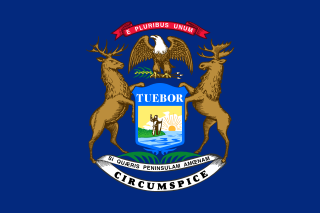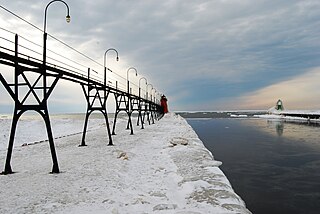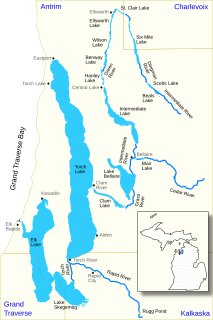| Little Cedar River | |
|---|---|
| Country | United States |
| Physical characteristics | |
| Main source | Meyer Township, Menominee County |
| River mouth | Menominee River 630 ft (190 m) [1] |
Little Cedar River is a 56.7-mile-long (91.2 km) [2] river in Menominee County in the U.S. state of Michigan.

Menominee County is a county located in the Upper Peninsula in the U.S. state of Michigan. As of the 2010 United States Census, the population was 24,029. The county seat is Menominee. The county's name comes from an American Indian word meaning "wild rice eater" used to describe a tribe. The county was created in 1861 from area partitioned out of Delta County, under the name of Bleeker. When county government was organized in 1863, the name was changed to Menominee.

In the United States, a state is a constituent political entity, of which there are currently 50. Bound together in a political union, each state holds governmental jurisdiction over a separate and defined geographic territory and shares its sovereignty with the federal government. Due to this shared sovereignty, Americans are citizens both of the federal republic and of the state in which they reside. State citizenship and residency are flexible, and no government approval is required to move between states, except for persons restricted by certain types of court orders. Four states use the term commonwealth rather than state in their full official names.

Michigan is a state in the Great Lakes and Midwestern regions of the United States. The state's name, Michigan, originates from the Ojibwe word mishigamaa, meaning "large water" or "large lake". With a population of about 10 million, Michigan is the tenth most populous of the 50 United States, with the 11th most extensive total area, and is the largest state by total area east of the Mississippi River. Its capital is Lansing, and its largest city is Detroit. Metro Detroit is among the nation's most populous and largest metropolitan economies.
The Little Cedar rises in Meyer Township at 45°45′00″N87°39′17″W / 45.75000°N 87.65472°W , [1] approximately 4 miles (6.4 km) northwest of Hermansville. It flows primarily south through Hermansville, then along the western side of Nadeau Township, passing briefly into Faithorn Township, and continuing through the village of Daggett, Daggett Township, the city of Stephenson, Stephenson Township, and into Mellen Township, where it empties into the Menominee River at 45°45′00″N87°39′17″W / 45.75000°N 87.65472°W . [1] Much of its course runs approximately parallel to US 41.

Meyer Township is a civil township of Menominee County in the U.S. state of Michigan. The population was 1,036 at the 2000 census. Hermansville is an unincorporated village within the township, and is where most of the population is concentrated.

Hermansville is an unincorporated community in the Meyer Township of Menominee County in the U.S. state of Michigan. It formed around the defunct Wisconsin Land & Lumber Company as a company town. The company's former headquarters is open as the IXL Historical Museum. U.S. Route 2 passes through the north edge of the community.

Nadeau Township is a civil township of Menominee County in the U.S. state of Michigan. The population was 1,160 at the 2000 census.












